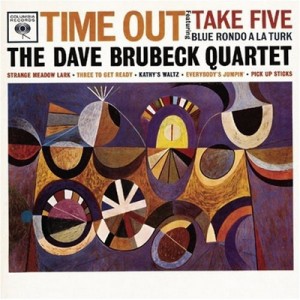 Here’s a very famous solo from Paul Desmond, being played with Dave Brubeck. I know this one is a cliche, and that there’s many purists who scoff at the idea of this tune, but I love Desmond and had this solo in my archives, so why not? Right?
Here’s a very famous solo from Paul Desmond, being played with Dave Brubeck. I know this one is a cliche, and that there’s many purists who scoff at the idea of this tune, but I love Desmond and had this solo in my archives, so why not? Right?
I actually picked this one years ago for the Arizona School for the Arts Showcase event (our MEGA, end-of-the-year concert). Our pit orchestra played this behind the Ballet. The arrangement we purchased left a lot to be desired so I rewrote it and added a Basie-esque harmonization of Desmond’s solo to give the sax players something interesting to do.
A little analysis
The solo is very short, and as this album really represented jazz’s first significant adventure into odd meter, it doesn’t stretch very far rhythmically. Much more interesting is Desmond’s use of articulation and sequence.
Let’s look at articulation first.
Desmond doesn’t follow the “traditional” bebop articulation pattern of tonguing primarily off beats and accented notes. Instead, he appears to ad-lib his articulations based on the shape of his line. Note the opening phrase of the head. He semi-ghosts the first two notes, accents the 3rd and possibly the fourth. The chromatic part of the lick has a slur from the downbeat to a dramatic staccato, and then all the remaining notes are tongued. This gives his line a dramatic and very unique percussiveness that, to my ear, transforms the lick. The tune loses much of its personality and life when the details Desmond added are missing. As with any solo, take time to match the recording for all the style elements that are tough to represent on paper.
I’ve seen this solo written out a few times in books…they tend to oversimplify some of the more surprising note choices by assuming he is simply playing in thirds on most of the pseudo-arpeggios. Note that most of the shapes are based on a C-6 (concert Eb-6) chord, and a strong emphasis of the note F (concert Ab). To my ear, the F implies an F7 and a mild suspension.
My favorite moment is the phrase from measure 49 to 56. Its a nice rising sequence and it really plays of the bright color of the major 6 of the Dorian scale.
Happy shedding!


hey i need help with my music assignment and was just wondering where the riff is found in the origional piece and just explain how the beginning of the original is played ? this would help me alot
I’m not sure I understand your question. What riff are you referring to? If you mean the head of the tune, its at the beginning where most heads are usually played, though its unusual for being in 5/4.
His solo is what I’d call “motivic” in the sense that he takes certain rhythmic patterns and develops them over the solo. His whole improvisation is really based on a very small handful of interesting short phrases.
Hope that helps.
Hey, if you like video tutorial come to our site. Actually some solution easy to understand in video. So come and i think you go you solution easily.
Hi,
We just printed your version in Es minor for our 9 year old son, playing alto sax, but we can’t find piano accompaniment. His teacher wants me to find it, otherwise he couldn’t play it. Can you help me with the piano accompaniment transcription?
Thank you for your help.